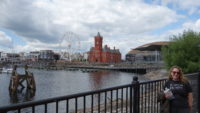 Today we traveled back two thousand years, navigated a river, went to Norway, went blind, walked out on that dam thing, went to Antarctica, and went shopping when we weren’t allowed to buy anything. We had a busy day.
Today we traveled back two thousand years, navigated a river, went to Norway, went blind, walked out on that dam thing, went to Antarctica, and went shopping when we weren’t allowed to buy anything. We had a busy day.
We drove into Cardiff, taking about twenty minutes, and even successfully found a parking garage near our destination of Cardiff Bay, which is about two miles south of the city center (or “centre”). We passed the rather humdrum-looking Welsh parliament building, and then passed the really spiffy Welsh parliament building (the first building looked like and thus probably was an office building attached to the meeting place of the parliament). We got situated in front of the ornate and very red Pierhead Building.
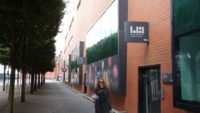 In 1800 Cardiff was a village of about two thousand people. By 1900, the population was almost one hundred times that. Cardiff Bay had become one of the leading ports for the export of coal, and specifically Welsh coal, which burned more warmly and cleanly than most coals. It made Cardiff very, very rich, and the city expanded the dock areas four times and installed almost two hundred miles of railroad in the city to handle all of the freight. To coordinate and supervise (and charge ships for) all of this coming and going, the man who owned the docks built a large terra cotta (red clay) building to house the clerks and managers of the docks. It is now owned by the Welsh Parliament and houses a quick history of the city, including a wonderfully self-aware, cheesy animated film that started with the Romans coming and building a fort around 55 AD and worked up to present day.
In 1800 Cardiff was a village of about two thousand people. By 1900, the population was almost one hundred times that. Cardiff Bay had become one of the leading ports for the export of coal, and specifically Welsh coal, which burned more warmly and cleanly than most coals. It made Cardiff very, very rich, and the city expanded the dock areas four times and installed almost two hundred miles of railroad in the city to handle all of the freight. To coordinate and supervise (and charge ships for) all of this coming and going, the man who owned the docks built a large terra cotta (red clay) building to house the clerks and managers of the docks. It is now owned by the Welsh Parliament and houses a quick history of the city, including a wonderfully self-aware, cheesy animated film that started with the Romans coming and building a fort around 55 AD and worked up to present day.
 Coal demand dropped after WW II with cheap imported coal becoming available, and Cardiff’s economy suffered. The docks transformed to handle big cargo container ships, but even that dried up, and so by the late 1970s, the bay area was an abandoned industrial wasteland. Enter the town council, who came up with the radical plan in the mid 1980s to dam up the mouth of the harbor. Cardiff Bay has huge tides (I estimated the tide marks to be pushing twenty-five feet), which made the harbor hard to manage. The plan was to make the inner harbor a stable freshwater lake fed by the River Taff, with a lock system to the sea for shipping and a fish ladder for the fish. They managed to get the thing passed and built, and the plan worked. The harbor is now a beautiful zone of shopping and culture and government buildings, and a walking and biking path now circles the whole bay.
Coal demand dropped after WW II with cheap imported coal becoming available, and Cardiff’s economy suffered. The docks transformed to handle big cargo container ships, but even that dried up, and so by the late 1970s, the bay area was an abandoned industrial wasteland. Enter the town council, who came up with the radical plan in the mid 1980s to dam up the mouth of the harbor. Cardiff Bay has huge tides (I estimated the tide marks to be pushing twenty-five feet), which made the harbor hard to manage. The plan was to make the inner harbor a stable freshwater lake fed by the River Taff, with a lock system to the sea for shipping and a fish ladder for the fish. They managed to get the thing passed and built, and the plan worked. The harbor is now a beautiful zone of shopping and culture and government buildings, and a walking and biking path now circles the whole bay.
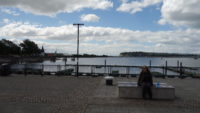 Several boating companies offer cruises in the harbor or up the river, and so it was that after we toured Pierhead, we got on a boat that cruised up the river to about where Cardiff Castle is. We had a commentary along the way, and learned that the Victorians moved the river to a new course to make the land around the castle more stable. We also discovered that the 75,000-seat sports arena cost twice as much to build as the parliament building, which I think has much to say about priorities. That is also the arena that Pink is playing tomorrow night, so if you estimate that thirty or forty thousand people coming to the concert need somewhere to stay, you can see why Meredith had a hard time finding us a hotel for this week.
Several boating companies offer cruises in the harbor or up the river, and so it was that after we toured Pierhead, we got on a boat that cruised up the river to about where Cardiff Castle is. We had a commentary along the way, and learned that the Victorians moved the river to a new course to make the land around the castle more stable. We also discovered that the 75,000-seat sports arena cost twice as much to build as the parliament building, which I think has much to say about priorities. That is also the arena that Pink is playing tomorrow night, so if you estimate that thirty or forty thousand people coming to the concert need somewhere to stay, you can see why Meredith had a hard time finding us a hotel for this week.
After the cruise, we popped quickly into the Norwegian church on the bay. It was built for Norwegian sailors who traded here, and eventually fell into disuse and disrepair. It was taken down and put into storage for a few years, and then rebuilt and restored on the bay during the 1990s. It is now a cafe on the ground floor, and a not-too-subtle branch of the Norwegian tourist board on the second floor, telling you all the great places you should come and see in Norway.
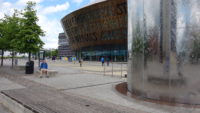 After the church, we went over to Roald Dahl Plass (place) to look at the pretty square in front of the very pretty and unusual opera house, the Wales Millennium Centre. The building is open even when performances aren’t showing, so we popped in to look around. Most of the food places were closed (the bay area was very quiet today – Mer thought we were too early in the summer for the main tourist time), but we stumbled on a little six-seat theater showing a film of a paralyzed woman joyfully gliding around underwater in a specially fitted-out wheelchair. It’s part of a partnership with a local theater that puts people with disabilities on stage with fully functional performers. We even came back after lunch to do the next experience, which was putting on a VR headset to experience what it is like to be blind.
After the church, we went over to Roald Dahl Plass (place) to look at the pretty square in front of the very pretty and unusual opera house, the Wales Millennium Centre. The building is open even when performances aren’t showing, so we popped in to look around. Most of the food places were closed (the bay area was very quiet today – Mer thought we were too early in the summer for the main tourist time), but we stumbled on a little six-seat theater showing a film of a paralyzed woman joyfully gliding around underwater in a specially fitted-out wheelchair. It’s part of a partnership with a local theater that puts people with disabilities on stage with fully functional performers. We even came back after lunch to do the next experience, which was putting on a VR headset to experience what it is like to be blind.
That is very odd, I know, but it worked really well. The VR headset piped in the audio diary of a man who had gone blind as an adult, and the recordings were all of him describing how he “saw” the world through sound. On the VR screen, we could only see dim sketchy outlines of things, and only if they made noise. So the man would describe how the wind or the rain made the world come alive for him, and we could see the outlines of trees rustling in the wind or rain. The entire experience lasted about twenty minutes and was very captivating.
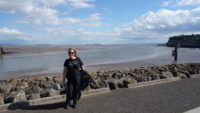 From there, we walked around the harbor out to the Barrage, the dam that was built to keep the tides out of the harbor. People were out walking and biking and enjoying the space. When we got to the Barrage, I was surprised to see mud flats almost as far as I could see – the tide was out, and I could see the line the high tide left on piers, which is where I guessed they had twenty-five-foot tides (I just looked it up – they have twenty-eight-foot tides). Well out on the dam are a couple of large sails to cover a pavilion, so we walked over to that and discovered a short display on the failed Scott expedition to the South Pole back in 1911. Scott had raised about half of his funds from Cardiff, and he set sail from Cardiff Bay, promising to stop in Cardiff first on the way back. Sadly, Scott never made it back from Antarctica. He and four companions trudged all the way to the South Pole (only to find out that a Norwegian named Amundsen had beaten them there by a few weeks) and then made it most of the way back to where the rest of the crew were waiting; however, before reaching them, Scott and the four others succumbed to exhaustion and a blizzard.
From there, we walked around the harbor out to the Barrage, the dam that was built to keep the tides out of the harbor. People were out walking and biking and enjoying the space. When we got to the Barrage, I was surprised to see mud flats almost as far as I could see – the tide was out, and I could see the line the high tide left on piers, which is where I guessed they had twenty-five-foot tides (I just looked it up – they have twenty-eight-foot tides). Well out on the dam are a couple of large sails to cover a pavilion, so we walked over to that and discovered a short display on the failed Scott expedition to the South Pole back in 1911. Scott had raised about half of his funds from Cardiff, and he set sail from Cardiff Bay, promising to stop in Cardiff first on the way back. Sadly, Scott never made it back from Antarctica. He and four companions trudged all the way to the South Pole (only to find out that a Norwegian named Amundsen had beaten them there by a few weeks) and then made it most of the way back to where the rest of the crew were waiting; however, before reaching them, Scott and the four others succumbed to exhaustion and a blizzard.
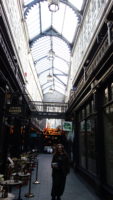 That wrapped up our tour of Cardiff Bay. We walked back to the car and moved it two miles to a new parking garage, taking about twenty-five minutes to do so (traffic was difficult). Having parked near the castle, we did a tour written up by Mer’s favorite guidebook author, Rick Steves. Since it was after 5:00, most things were closed, and so several of the things Rick pointed out we couldn’t check out. We did have supper at the start of the walk, and then ended up heading away from the castle along the two main pedestrian shopping zones. There are several Victorian glass-roofed shopping arcades along the way, and we even managed to get into part of one that had an open restaurant, but all the shops were closed, so we couldn’t stroll the arcade. Much the same was true for the rest of the pedestrian zone – the restaurants were open, but the shops weren’t. Or the main church. Or the old library. But it was still a lovely walk – I do love pedestrian-only zones in town centers.
That wrapped up our tour of Cardiff Bay. We walked back to the car and moved it two miles to a new parking garage, taking about twenty-five minutes to do so (traffic was difficult). Having parked near the castle, we did a tour written up by Mer’s favorite guidebook author, Rick Steves. Since it was after 5:00, most things were closed, and so several of the things Rick pointed out we couldn’t check out. We did have supper at the start of the walk, and then ended up heading away from the castle along the two main pedestrian shopping zones. There are several Victorian glass-roofed shopping arcades along the way, and we even managed to get into part of one that had an open restaurant, but all the shops were closed, so we couldn’t stroll the arcade. Much the same was true for the rest of the pedestrian zone – the restaurants were open, but the shops weren’t. Or the main church. Or the old library. But it was still a lovely walk – I do love pedestrian-only zones in town centers.
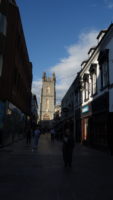 And that was our day. We drove back to our Pink-inspired hotel on the edge of the city, where we got candy bars from the handy rest-stop store. We both agreed we aren’t going anywhere near downtown tomorrow night. We probably couldn’t get tickets to the concert anyway.
And that was our day. We drove back to our Pink-inspired hotel on the edge of the city, where we got candy bars from the handy rest-stop store. We both agreed we aren’t going anywhere near downtown tomorrow night. We probably couldn’t get tickets to the concert anyway.